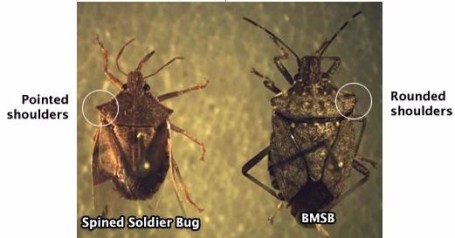Winter Pest Alert
January 26, 2018 at 10:00 am smithsoniangardens Leave a comment
As the cold days and nights of winter settle in, you might find relief from some of the nuisance pest outdoors – such as mosquitoes, aphids and other general insect invaders. However, what this may also mean for you, especially if you live an older home, is that you will start to notice some pests indoors that you might not have expected.

Brown Marmorated Stinkbug (BMSB). Photo courtesy: PSU Extension
One such invader that moves inside as temperatures drop is Halyomorpha halys, also kindly or not so kindly known as the Brown Marmorated Stinkbug (BMSB). For anyone who has encountered these mottled brown shield-shaped insects, you know that if you agitate them enough you will get a nasty response in the form of a chemical scent defense, a smell that can persist long after they are dead.
BMSB is an introduced insect pest species native to Japan, China, Taiwan and both North and South Korea. BMSB was introduced to the U.S. in the late 1990’s and is considered a problematic agricultural pest as it attacks a wide range of crops and fruits including soybeans, apples, grapes, and raspberries. In their native range, BMSB have natural predators that help to keep populations low; however, here in the U.S. there are few predators that will take on eating the distasteful and odorous insect.
One feature that makes BMSB more aggravating to the homeowner is that they overwinter in large groups, using an aggregation pheromone to call other BMSB to them. They usually overwinter in protected areas such as the underside of bark and trees, though this could also mean along the edges of your house. And BMSB are very opportunistic in that if they can find a way inside when the temperatures really drops they will. You might find a large number in your attic, chimney, or crawl space.
It is a good idea to start seal up any cracks or crevices you may have in your home, fix any torn screens, and DON’T SQUISH THEM! If you see a few it’s fine to remove them by hand, with a pair of gloves if you are concerned with the smell, but this should lead you to start checking seams around your house to see where they might be getting in. I would not suggest using harsh pesticides around your home. If you have a really bad infestation contact an experienced pest control agent.

Photo courtesy: stopbmsb.org
Finally, it is important to note that not all stinkbugs are bad; we even have a species native to this area that is considered a beneficial insect – the Spined Soldier Bug. The Spined Soldier Bug looks very similar to BMSB and can be difficult to distinguish in the field. If you are unsure, reach out to a local extension agency who can make the identification for you.
– Holly Walker, Smithsonian Gardens Plant Health Specialist
Entry filed under: Uncategorized.

Trackback this post | Subscribe to the comments via RSS Feed